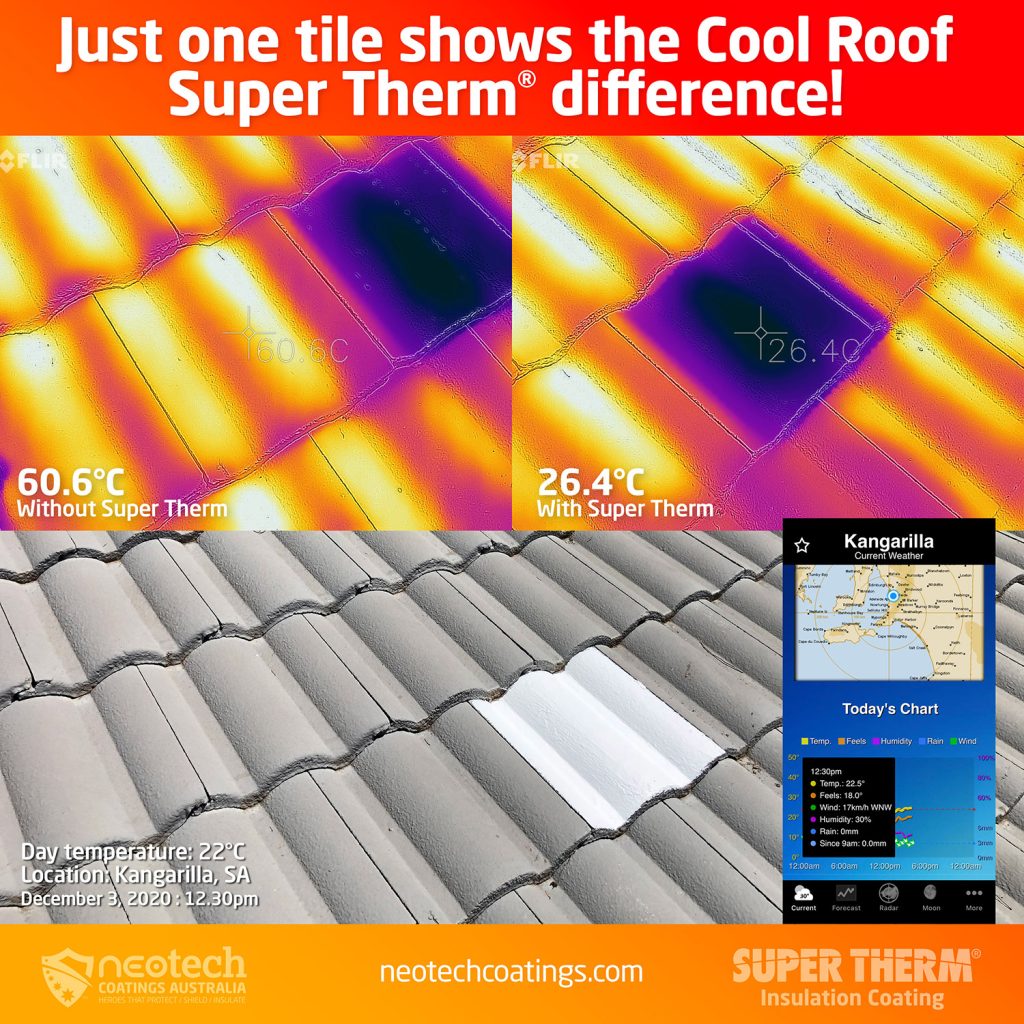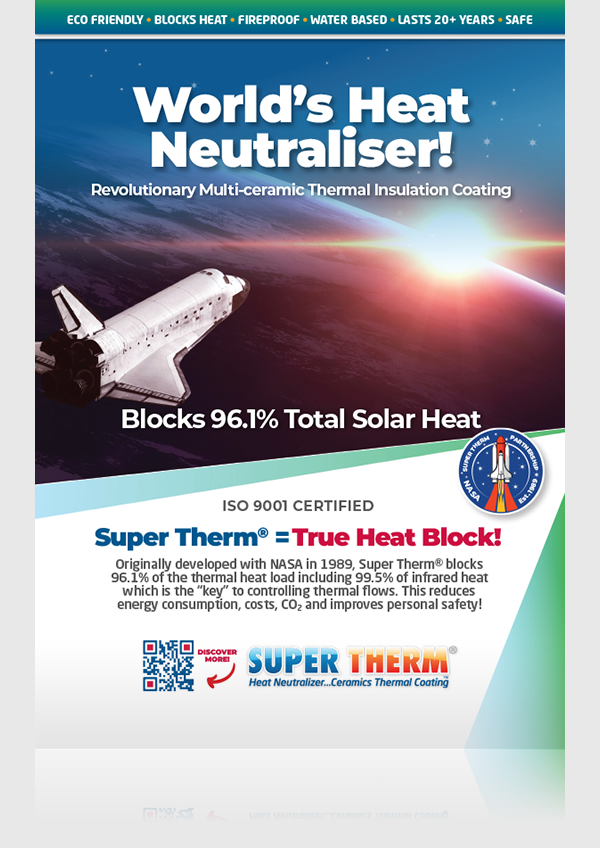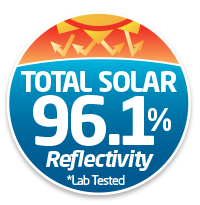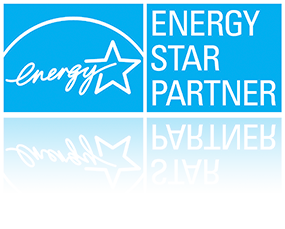Exploring Energy-Efficient Cool Roofings for a Sustainable Home
When incorporating cool roofing options, it’s important to consider the overall energy efficiency of the building envelope, which includes the roof, walls, windows, and insulation. By improving the overall energy efficiency of the building envelope, you can reduce heat transfer, enhance thermal comfort, and minimise the need for heating or cooling systems.
Exploring energy-efficient cool roofing options is an excellent approach to promoting sustainability in your home. Here are some ideas you can consider for energy-efficient cool roofing. They all offer different results with regard to reflectivity, solar absorption and solar transmittance yet do vary increasing the sustainability of homes and buildings:
- Insulation Cool Roof Coatings: Insulation coatings are able to not only reflect heat but block it. This is the optimal way to protect from the sun’s heat, particularly with retrofitting a building; whether it’s a residential home, commercial, factory or anything where you want to stop and block heat load.
- Reflective Roof Coatings: Apply reflective roof coatings to your existing roof or choose roofing materials that have built-in reflective properties. These coatings are designed to reflect sunlight and reduce heat absorption, keeping your home cooler and reducing the need for air conditioning.
- Cool Roofing Materials: Opt for cool roofing materials that have high solar reflectance and thermal emittance. Materials such as metal, tile, clay, or specially designed cool asphalt shingles can help reflect more sunlight and emit absorbed heat more efficiently than traditional roofing materials.
- Green Roofs: Implement a green roof system, which involves adding a layer of vegetation on top of your roof. Green roofs provide insulation, reduce the heat island effect, and absorb rainwater, all of which contribute to energy efficiency and sustainability..
- Insulation: Ensure proper insulation in your attic or roof space. Insulation helps maintain a stable indoor temperature by preventing heat transfer between the roof and the interior of your home. It reduces the reliance on heating and cooling systems, leading to energy savings.
- Ventilation: Incorporate effective ventilation systems, such as ridge vents, soffit vents, or attic fans, to promote airflow and heat dissipation. Proper ventilation prevents the buildup of heat in your roof and attic, reducing the strain on your cooling systems.
- Energy-Efficient Roof Design: Consider the overall roof design and its orientation. For example, a lighter-coloured roof with a steeper slope can reflect more sunlight and facilitate better air circulation. An optimal roof design can significantly impact the energy efficiency of your home.
- Energy Monitoring Systems: Install energy monitoring systems to track and analyze your energy consumption patterns. These systems can help you identify areas of improvement and adjust your energy usage accordingly.
- Local Climate Considerations: Take into account your local climate when selecting roofing options. For hot climates, prioritise materials with high solar reflectance and effective heat dissipation properties. In colder regions, focus on insulation and materials that retain heat.
- Professional Consultation: Consult with roofing professionals or sustainable building experts who can assess your home’s specific requirements and suggest tailored energy-efficient cool roofing options. They can provide valuable insights and recommendations based on local regulations, available incentives, and the unique characteristics of your home.
By implementing energy-efficient cool roofing options, you can reduce your environmental impact, lower energy bills, and create a more sustainable and comfortable living space. The appropriate amount of heat to be blocked, not just reflected by a roof is commonly measured by a property known as solar reflectance, also referred to as reflectivity or albedo (whiteness). Solar reflectance is a measure of how well a surface reflects solar radiation (sunlight) rather than absorbing it. This however isn’t the best measure for blocking solar heat load.
For the best cool roofing options, consider a high solar reflectance value, high emissivity and high thermal blocking.
The cool roof industry are developing materials in a simplified manner designed to reflect a significant portion of the solar visual radiation they receive, which in part reduces 47% of the solar heat absorption and keeping the roof and the surface cooler.
The solar reflectance of a cool roof is typically expressed as a value between 0 and 1, with 1 representing a perfectly reflective surface that reflects all incoming solar radiation. The higher the solar reflectance value, the more effective the roof is at reflecting solar heat.
In terms of specific solar reflectance values, cool roofing materials typically have a minimum requirement to meet certain energy efficiency standards. For example, in the United States, the ENERGY STAR program for roofing requires a solar reflectance of at least 0.25 for low-slope roofs and 0.15 for steep-slope roofs. We consider these values very low and a poor benchmark. There are also cool roofing options available with significantly higher solar reflectance values, often exceeding 0.70 or even 0.80.
It’s important to note that the appropriate solar reflectance value for a roof may vary depending on factors such as climate, local building codes, and energy efficiency goals. There are other factors including the formulation and materials in coatings that will contribute to higher performances.
U-values of cool roof options compared with SRI
When discussing the energy efficiency of roofs, U-values are not typically used to describe cool roof options because they are more challenging to establish. U-value, also known as thermal transmittance, is a measure of the rate of heat transfer through a building element, such as a roof or wall. It quantifies how much heat can pass through a material per unit area for a given temperature difference.
Globally the cool roof industry rely on the Solar Reflectance Index (SRI) yet as explained before, SRI doesn’t give you any meaningful thermal transmittance information. U-values are commonly used to assess the insulation properties of building components, including walls, windows, and doors. They indicate how well a material or assembly resists heat flow, with lower U-values indicating better insulation and reduced heat transfer.
Cool roof options, on the other hand, focus on the roof’s ability to reflect solar radiation and reduce heat absorption rather than insulation properties. Therefore a focus on SRI won’t give you insulation value.
The solar reflectance (reflectivity) and thermal emittance of the roofing material are the key parameters for cool roofs but can’t give meaningful thermal values for sustainable performance.
Solar reflectance (reflectivity) and thermal emittance relative heat values are not absolute values
Solar reflectance (reflectivity) and thermal emittance are relative heat values, not absolute values. They represent the performance of a roofing material compared to standard reference values. Solar reflectance measures the percentage of solar radiation reflected by a surface compared to a standard black surface (which has a solar reflectance of 0) or a standard white surface (which has a solar reflectance of 1). It indicates how effectively a roof can reflect sunlight and reduce heat absorption.
Thermal emittance, on the other hand, measures the ability of a surface to emit or radiate thermal energy (heat) away from its surface compared with a perfect black body radiator (which has a thermal emittance of 1). It represents the roof’s ability to release absorbed heat back into the atmosphere.
Both solar reflectance and thermal emittance are important factors in evaluating the energy efficiency of a cool roof because they contribute to the reflecting and emitting heat. High solar reflectance and high thermal emittance values indicate that the roofing material can effectively reflect visual sunlight and radiate away absorbed heat, thereby reducing the heat transfer into the building. However, not focusing on the infrared radiation from the sun means there’s additional heat that can be blocked giving you additional sustainability opportunities.
It’s worth noting that the specific values of solar reflectance and thermal emittance can vary depending on the testing methods and standards used. Different regions or organisations may have their own benchmarks or criteria for cool roofing materials. Therefore, it’s important to refer to applicable standards or certifications, such as ENERGY STAR or LEED, when evaluating the solar reflectance and thermal emittance properties of roofing options.
So if SRI is a relative value, not an absolute value, how do you know how much heat is being transferred?
Solar reflectance and thermal emittance are relative values the industry use to indicate the relative performance of a roofing material compared to standard reference values and thermal transmittance. They do not directly provide information on the absolute amount of heat being transferred. Read why SRI isn’t a great standard.
To determine the actual amount of heat being transferred through a roofing system, additional factors such as insulation, air leakage, and the thermal properties of the building envelope need to be considered. This requires conducting a more comprehensive energy analysis or using specialised testing. Therefore in context, SRI is considered ‘easier’ as a value despite not giving direct thermal value that can be measured for a buildings sustainability. Simply an assumption of thermal benefits.
Energy modeling software can simulate the thermal behaviour of a building and calculate heat transfer through various building components, including the roof. By inputting specific details about the roofing material, insulation levels, climate data, and other relevant factors, the software can estimate the amount of heat gained or lost through the roof.
This analysis takes into account factors such as solar radiation, ambient temperature, roof surface temperature and heat conduction through the roof assembly. It provides a more accurate understanding of the energy performance of the roof and the building as a whole.
To obtain precise information about heat transfer and energy efficiency, it is advisable to consult with energy professionals, architects, or engineers who specialize in energy modeling and building performance analysis. They can assess your specific building characteristics, climate conditions, and objectives to provide detailed insights into heat transfer and energy consumption, helping you make informed decisions about energy-efficient roofing options.
What is a good measurement for absolute heat being transferred?
A good measurement for the absolute heat being transferred through a roofing system is the U-value or thermal transmittance. The U-value quantifies the rate of heat transfer per unit area, typically expressed in watts per square meter per Kelvin (W/m²K) or British thermal units per hour per square foot per degree Fahrenheit (BTU/h·ft²·°F).
The U-value considers the entire heat transfer process, including conduction, convection, and radiation, and provides a comprehensive assessment of the thermal performance of a building component, such as a roof. It takes into account the thermal conductivity of the materials used, the thickness and configuration of the roof assembly, and other factors affecting heat transfer.
A lower U-value indicates better insulation and reduced heat transfer. A higher U-value signifies higher heat transfer rates and lower thermal efficiency. By minimising the U-value of the roofing system, you can limit the amount of heat that is transmitted through the roof into the building interior.
It’s important to note that U-values are typically determined through laboratory testing or sophisticated computer simulations that consider the specific materials, construction methods, and environmental conditions. Consulting with professionals experienced in energy modelling or building science can help accurately determine the U-value of a roofing system in your specific context.
Additionally, it’s worth considering other metrics such as R-value (thermal resistance) and total heat gain or loss calculations, which provide further insights into the energy efficiency and performance of the roofing system. These measurements consider not only heat transfer but also other factors such as solar radiation, air leakage, and overall energy consumption.
Is there a formula for measuring temperatures from a roof to convert into watts per square meter per Kelvin (W/m²K)?
ASHRAE (American Society of Heating, Refrigerating, and Air-Conditioning Engineers) provides guidelines and standards for various aspects of building energy performance, including thermal properties. However, ASHRAE does not provide a specific formula for converting roof temperatures into U-values (watts per square meter per Kelvin, W/m²K).
To determine U-values for building components like roofs, ASHRAE recommends using recognised calculation methods, such as those outlined in the ASHRAE Handbook of Fundamentals or applicable building energy codes and standards. These methods involve considering factors such as material properties, insulation levels, air films, and construction details.
ASHRAE’s Handbook of Fundamentals includes detailed information on heat transfer calculations, thermal properties of materials, and various factors affecting the thermal performance of building components. It provides guidance on determining U-values based on specific construction assemblies and relevant parameters.
To accurately determine the U-value of a roof or any building component, it is advisable to consult the appropriate standards, guidelines, or professionals in the field of building science and energy modelling. They can assess the specific characteristics of your roof assembly, consider local climate conditions, and employ appropriate calculation methods to provide accurate U-value measurements.
What is an example of watts per square meter per Kelvin (W/m²K)?
An example of watts per square meter per Kelvin (W/m²K) is the U-value of a building component that represents the rate of heat transfer per unit area per degree Kelvin temperature difference.
Let’s say you have a roof assembly with a U-value of 0.25 W/m²K. This means that for every 1 Kelvin (or 1 degree Celsius) temperature difference between the inside and outside of the building, the roof assembly will allow heat to transfer at a rate of 0.25 watts per square metre.
To illustrate, if the temperature difference between the interior and exterior of the building is 10°C, the heat transfer rate through each square meter of the roof assembly would be: 0.25 W/m²K × 10 K = 2.5 watts per square metre.
In this example, for every square metre of the roof assembly, there would be a heat transfer of 2.5 watts when there is a 10°C temperature difference between the inside and outside of the building.
Remember that U-values are a measure of heat transfer per unit area per degree temperature difference and are used to assess the thermal performance and insulation effectiveness of building components such as roofs, walls, windows, and doors.
Does Super Therm have a watts per square meter per Kelvin (W/m²K) rating?
Super Therm® Multi Ceramics Thermal Insulation Coating is a thermal barrier and insulating coating. It is has a specific U-value or watts per square meter per Kelvin (W/m²K) measurement and SRI rating. U-values or thermal transmittance values are typically associated with building components, such as roofs, walls, or windows. They quantify the rate of heat transfer through these components per unit area per degree temperature difference.
Super Therm® blocks and reflects solar radiation and reduces heat absorption, thereby reducing heat transfer through the coated surface using 4 specialised ceramics. It contributes to improving the thermal performance of a building by reducing heat gain.
To assess the thermal performance of a building component coated with Super Therm®, you would typically consider the U-value of the underlying material or system, which is then modified by the reflective properties of the coating.
It’s important to note that specific U-values and thermal performance measurements would depend on the entire roof assembly or building envelope system, including insulation, air gaps, and other factors. Consulting professionals or conducting appropriate testing and analysis would be necessary to determine the overall thermal performance of a specific roof or building system incorporating Super Therm® or any other coating product.
What is the U-value for Zincalume®?
As an example, the U-value of Zincalume®, which is a specific type of steel coated with a zinc-aluminum alloy, depends on various factors such as the thickness of the material, insulation used, and the overall roof assembly. It is challenging to provide an exact U-value for Zincalume® without considering these factors.
However, as a reference, typical U-values for Zincalume® roofing systems range from around 0.50 W/m²K to 0.70 W/m²K. These values are estimates and can vary based on specific configurations, insulation levels, and other design factors.
What is the U-value for concrete tiles?

The U-value of concrete tiles can vary depending on several factors, including the thickness and composition of the tiles, the presence of insulation, and the overall roof assembly. Additionally, regional building codes and standards may provide specific requirements for U-values.
As a rough estimate, typical U-values for concrete tile roofing systems range from approximately 0.80 W/m²K to 1.50 W/m²K. However, it’s important to note that these values can vary significantly based on specific roof designs, insulation levels, and other factors.
To determine the accurate U-value for a concrete tile roof, it is recommended to consult with building professionals or utilize appropriate calculation methods and modeling software. They can consider the specific characteristics of the roof assembly, insulation materials, climate conditions, and other relevant factors to provide precise U-value measurements for your specific context.
What are the U-values of a black over a white metal roof?
The U-value of a black metal roof and a white metal roof can vary depending on several factors, including the specific materials used, insulation levels, and the overall roof assembly.
Typically, black metal roofs have higher U-values compared to white metal roofs. This is because black surfaces tend to absorb more solar radiation, leading to increased heat transfer through the roof assembly. On the other hand, white surfaces reflect more visual solar radiation, resulting in lower heat absorption and reduced heat transfer.
As a rough estimate, U-values for black metal roofs can range from approximately 0.80 W/m²K to 1.50 W/m²K, while U-values for white metal roofs can range from approximately 0.40 W/m²K to 0.80 W/m²K. These values are approximate and can vary depending on specific roof designs, insulation levels, and other factors.
It’s important to note that these estimated U-values are for comparative purposes and can be influenced by various factors specific to the roof assembly. To obtain accurate U-values for a black or white metal roof in a specific context, it is recommended to consult with building professionals or use appropriate calculation methods and modelling software that consider the specific details of the roof assembly, insulation, climate conditions, and other relevant factors.
If the white roof has a lower U-value how can that be improved even more for thermal efficiency?
If a white metal roof already has a lower U-value than black, there are several ways to further improve its thermal efficiency:
- Increase insulation: Enhancing the insulation within the roof assembly can help reduce heat transfer. Adding insulation materials with higher R-values (thermal resistance) can effectively improve the overall thermal performance of the roof system.
- Improve air sealing: Ensure that the roof assembly has proper air sealing to minimise air leakage. Uncontrolled air movement can compromise the thermal efficiency of the roof. Seal any gaps, cracks, or openings to prevent air infiltration and exfiltration.
- Thermal insulation cool roof coating: While a white metal roof already reflects a significant amount of solar radiation, applying a thermal insulation roof coating can further enhance its thermal properties. Cool roof insulation coatings are designed to reflect and block more sunlight and reduce heat absorption, improving the roof’s overall thermal efficiency and reduce energy.
- Ventilation and airflow management: Proper ventilation in the roof cavity can help dissipate excess heat and reduce the potential for heat buildup. Effective airflow management, such as ridge vents, soffit vents, or other ventilation strategies, can help improve the overall thermal performance of the roof.
- Energy-efficient design: When designing or renovating the building, consider factors such as roof slope, orientation, shading, and thermal mass. Optimising these design aspects can contribute to improved thermal efficiency and reduce the reliance on mechanical cooling systems.
It’s important to note that the specific improvements will depend on factors such as the existing roof assembly, local climate conditions, budget considerations, and building codes. Consulting with building professionals or energy experts can provide tailored recommendations and strategies to enhance the thermal efficiency of a white metal roof for your specific project.
Do cool roofs reduce CO2 emissions, if so, how?
Cool roofs can contribute to reducing CO2 emissions through several mechanisms:
- Reduced energy consumption: Cool roofs have higher solar reflectance, meaning they reflect a greater portion of the sunlight that hits the roof surface. By reflecting and blocking more sunlight, cool roofs reduce the amount of solar heat absorbed by the building, thereby reducing the need for cooling energy. This can result in lower electricity demand for air conditioning, leading to decreased fossil fuel consumption and corresponding CO2 emissions from power generation.
- Decreased urban heat island effect: Urban areas often experience higher temperatures due to the absorption and re-radiation of heat by buildings and paved surfaces. Cool roofs help mitigate this urban heat island effect by reflecting more solar radiation and reducing surface temperatures. By reducing the overall heat island effect, less energy is required for cooling buildings and the demand for electricity decreases, resulting in reduced CO2 emissions.
- Increased roof longevity: Cool roofs can extend the lifespan of roofing materials by reducing thermal stress and degradation caused by excessive heat exposure. A longer-lasting roof reduces the need for frequent roof replacements or repairs, which in turn decreases the associated energy and material consumption, including the CO2 emissions associated with their production and transportation.
- Improved solar performance: Many tests and proven cool roofs reduce the local micro climate of a roof. This reduction in heat on the roof means the micro switches on PV panels remain cooler and keep the panels more efficient. This increase solar production.
It’s worth noting that the specific impact of cool roofs on CO2 emissions will vary depending on factors such as climate, building characteristics, energy consumption patterns, and the overall energy mix for power generation in a given region. However, by reducing energy demand and mitigating the urban heat island effect, cool roofs have the potential to contribute to the overall reduction of CO2 emissions and promote energy efficiency in buildings.

























